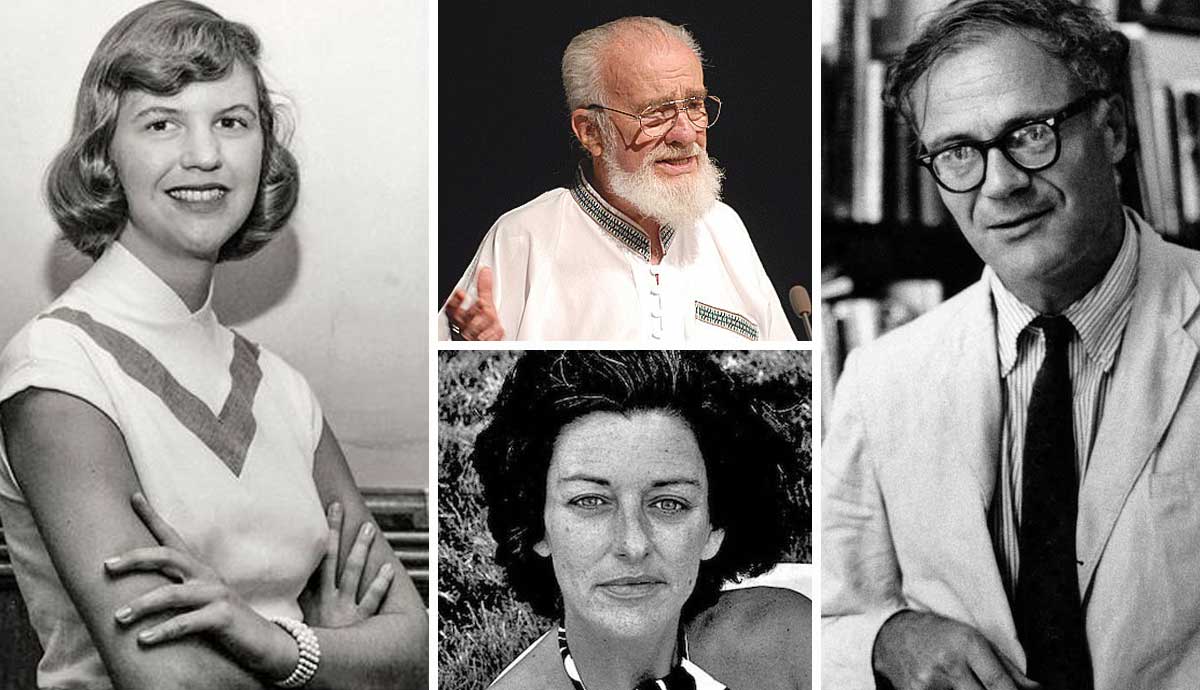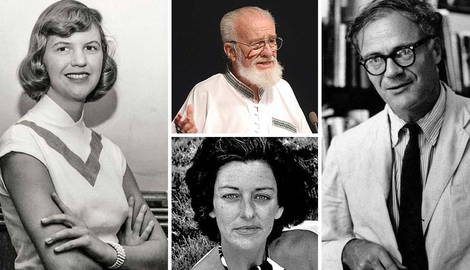
Confessional poetry was a highly personal verse. Colloquial language, rich images describing emotional states, missing universal symbols, and the ring of truth in the personal experience of actual events were the hallmarks of the new poetry. It was quickly published, won major awards, and gathered devotees. All four poets associated with the confessional poetry movement wrote poems to their daughters in this style. They are intense first-person accounts of their relationships, often pain-ridden, ultimately sweet. They serve as examples of new poetry and illustrate both the common ground and the dissimilarity among these four most notable writers of the confessional movement.
The Preamble to the Confessional Movement

Confession has a long history. St. Augustine wrote his autobiographical confession of faith, Confessions, between 397 and 400 A.D. Eight hundred years later, in 1215, the Catholic Church, during the Fourth Lateran Council, required confession at least once a year under threat of ex-communication.
Confession moved out of religion into the secular realm when Jean-Jacques Rousseau wrote his autobiographical Confessions between 1765 and 1788. As noted in Derek Matraver’s Introduction to the Wordsworth Classics edition of Rousseau’s Confessions, Rousseau was racked with a need to justify his life. The resulting autobiography of a man who had difficulty brooking opposition often seemed an attempt to induce the reader to adopt his point of view.
The urge to talk about one’s self, and perhaps by doing so, purge a buried demon and be absolved, whether by God or by public opinion, found scientific acceptance with Sigmund Freud. In 1886, he promulgated the “talking cure” in which the patient facilitated psychological healing by bringing the interior trauma to the surface through verbal communication.
Walt Whitman brought the beginnings of the confessional style to poetry. Writing in the second half of the nineteenth century, his poetic tone was more universal, but it carried the undeniable passion and the intimate “I” characteristic of confessional verse.
Consequently, when the confessional movement arrived in April 1959, the idea was hardly new. The newness derived from the no-holds-barred veracity of emotion and the public acceptance of it. As the culture changed and became more rebellious, everything became fair game. Abuse, gender, mental illness, sexuality, menstruation, and masturbation appeared in the new poetry, often accompanied by condemnation from the critics, but the trend to openness was unstoppable.
April 1959: The Confessional Movement Begins

Today most media and art forms proliferate with a confessional style: personal, apparently autobiographical, purgative. After its tentative beginnings hundred of years in the making, it suddenly bloomed into a primary mode of expression. The date of its beginning is precise, the thirteenth of April 1959.
On April 13, 1959, W.D. Snodgrass published Heart’s Needle, which carried the eponymous poem about the pain of being separated from his daughter due to a divorce. It won a Pulitzer Prize. On April 28, 1959, Robert Lowell published a highly autobiographical collection, Life Stories, about his struggles with bipolar disorder, which won the National Book Award.
A few months later, Anne Sexton’s poems appeared in several major magazines. In 1960, her first book of poetry, To Bedlam and Part Way Back was released. In 1963, Sylvia Plath’s novel about her attempted suicide and subsequent hospitalization was published in the UK under a pseudonym.

The floodgates opened for confession. Comedy became confessional and personal to the comedians. The light material of Bob Hope changed to the highly autobiographical darker comedy of Lenny Bruce and Richard Pryor. Personal stories of racism and oppression became accepted skits.
In performance art during the seventies, Linda Montano performed works she eventually entitled “The Story of My Life.” Montano would constrain herself with various accouterments, a brace around her mouth, a treadmill, and feminine clothing, then proceed to tell the story of her life for three hours. Feminism achieved a potency in this new personal form of expression that more sedate forms lacked.
LGBTQ confessional performances began in the late 1970s with Quentin Crisp. As an openly gay man his entire adult life, he became famous in his fifties with a television version of his autobiography which became a hit one-man show in the theater.
Reality TV, another medium for the confessional movement, began in 1973 with “An American Family” and continued with shows like “The Real World” in the 1990s. Finally, public platforms like Facebook and YouTube made public confession accessible to everyone.
Pro and con arguments proliferate about the value of the new style. It has been, perhaps fairly, charged with encouraging narcissism. On the other hand, it has raised awareness about abuse and the effects of racism, misogyny, and anti-LGBTQ bias on individuals. The confessional movement has had an enormous impact on modern culture.
1. W.D. Snodgrass

Born in 1926, William DeWitt Snodgrass served in the US Navy during World War II. Afterward, he resumed his studies at Geneva College, soon afterward moving to the University of Iowa where he was a student of Robert Lowell. In the course of his career, he taught at numerous colleges, spending the rest of his life on poetry, translations, teaching, and analysis. He died in 2009 at the age of 83, the only one of the four major confessional poets to reach his senior years.
His early relationship with his daughter, Cynthia Jean, is the subject of his most famous poem. Heart’s Needle is a seminal work of confessional poetry. In 1959, writing about the personal trauma of divorce and separation from a child was decidedly revolutionary. A quiet sadness permeates the poem, an awareness that the trajectory of the relationship is beyond his control.
“I lift you on your swing and must
shove you away,
see you return again,
drive you off again, then”
Snodgrass speaks directly to the child in this poem. The reader has a sense of overhearing the poet speaking quietly to the little girl as they sit on a park bench. Unlike any previous work of poetry, he reveals an unprecedented depth of emotion.
2. Robert Lowell
Robert Lowell was born in 1917. He studied Classics at Harvard and Kenyon College and English Literature at Louisiana State University. During World War II, he served time in a penitentiary rather than in the military. By 1946, he was an established poet. The next year, Lowell was the Consultant in Poetry for the Library of Congress. He was widely considered the most influential poet of the time. Teaching widely, Lowell taught both Anne Sexton and Sylvia Plath in the same seminar at Boston University. Snodgrass was his student at Iowa University.

His most famous work, Life Studies, came out within weeks of Snodgrass’ Heart’s Needle, adding a further dimension to the new poetry. A study pointed out that Lowell’s confessional poetry, like the realism of Tolstoy, Chekhov, and Flaubert often used metonymy, a literary tool similar to metaphor but instead of a flat substitution, it analogizes through association. (For example, “love is a red rose” is a metaphor. “You have my heart” is a metonymy because the heart is associated with love.)
Life Studies contains “Home After Three Months Away,” a poem in which Lowell reconnected with his daughter, Harriet, after spending three months in an institution due to his illness. He used her play as a metonymic device to reveal his own experience while away and the resulting “cure.”
The poet’s voice insists on his age but with ambiguity.
“Though I am forty-one,
Not forty now, the time I put away
Was child’s play.”
The mixing between man and child is especially revealing,
“. . . After thirteen weeks
my child still dabs her cheeks
to start me shaving. When
we dress her in her sky-blue corduroy,
she changes to a boy,
and floats my shaving brush
and washcloth in the flush. . . .”
Numbers play an important role in the poem. There is an obsessive tendency to count, “three stories down,” “seven horizontal tulips blow,” “just twelve months ago,” grounding the poem in time and place, as if the speaker needed the anchor of precision as a counterpoint to the child’s game with its evanescent quality of lather and water.
Like most confessional poetry, this poem was based on an actual event. Nevertheless, Lowell was able to keep his illness under a certain amount of control. Lowell died of a heart attack at sixty.
3. Anne Sexton

The American poet Anne Sexton appeared out of nowhere. She had married young; a housewife with two small daughters. After her own bout with mental illness, as part of the recuperation process, Sexton picked up poetry. She honed her skills, and by 1959, her works were appearing in major magazines.
“Little Girl, My Stringbean, My Lovely Woman” is addressed to her daughter Linda when she was eleven. Interestingly, Sexton performed this poem at Vietnam War protests, as if a poem full of lush imagery might serve as a contrast to the other grimmer stories being performed.
“the market stalls of mushrooms
and garlic buds all engorged.
Or I think even of the orchard next door,
where the berries are done
and the apples are beginning to swell”
Sexton often wrote about the female body, which aided in the growing awareness that a woman’s body was neither a sacred nor a profane object, as it had often been portrayed in the past, but instead was the flesh of a complete human being.
In true Sexton style, she mixes grotesque and beautiful images in her poem “Mother and Daughter,” addressed to her daughter at eighteen.
“Linda, you are leaving
your old body now,
It lies flat, an old butterfly,
all arm, all leg, all wing,
loose as an old dress.”
The poem’s end sees her daughter’s new womanhood as a precursor to the poet’s own demise:
“And you will see my death
drooling at these gray lips
while you, my burglar, will eat
fruit and pass the time of day.”
When the child is an adult and no longer needs the parents to care, the parent becomes, at least from a biological evolutionary standpoint, completely unnecessary. Sexton makes quite clear the ambivalence she feels as her daughter moves on.
4. Sylvia Plath

Like Sexton, Sylvia Plath rose quickly to the upper echelons of the literary world. In her short career before ending her life at thirty in 1963, she wrote 445 poems and a novel, The Bell Jar. She and her husband, Ted Hughes, also a poet, had two children: Frieda, who was two when her mother died, and Nicholas, who was an infant.
“Morning Song” was addressed to her daughter and appears in Ariel, a posthumous collection that cemented her contribution to the confessional movement. “Love set you going like a fat gold watch.” As Plath noted, having children heightens the awareness of the passage of time. The ambiguity between wonder and cold awareness is apparent in the next lines:
“Our voices echo, magnifying your arrival. New statue.
In a drafty museum, your nakedness
Shadows our safety. We stand round blankly as walls.”
The confessional poetry movement ostensibly ended in the 1970s. Since then, it has morphed into other disciplines. Confession has long since spread beyond the realms of art. Nevertheless, confessional poetry arguably has impacted society much more than most literary movements. The impetus for confession in verse removed the barrier that made personal trauma improper for discussion. Without the cultural freedom to speak, injustice is far more likely to occur and the experiences of others to be misunderstood. As a parent influences his or her child, confessional poetry influenced the social structure of the generations following it. Despite the personal tone, the final words in Sylvia Plath’s “Morning Song” to her daughter have a prophetic resonance.
“. . . And now you try
Your handful of notes;
The clear vowels rise like balloons.”










